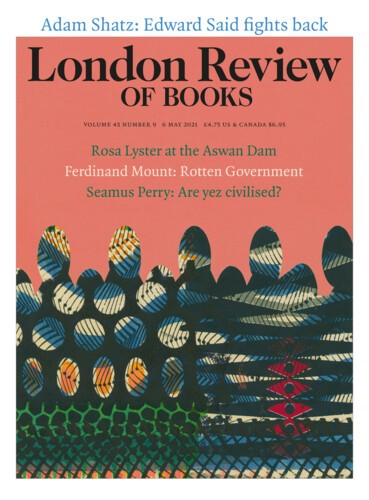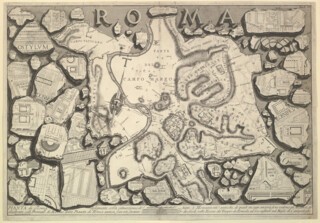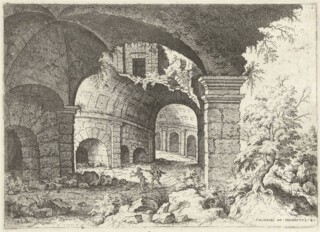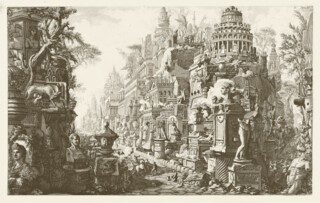The life of a Renaissance antiquarian was far from simple. In April 1436, when Cyriac of Ancona arrived in Athens, he was thrilled by his first sight of the Parthenon, the ‘marvellous marble temple of the goddess Pallas, the divine work of Phidias’. He counted its columns, admired its friezes and commented on the artistry with which Phidias had represented the battle of the Centaurs and Lapiths. He even sketched the building on the spot. Only a fair copy of his sketch survives. It omits important details but conveys the powerful impression that the building made on him. Carried back in spirit to the ancient world, Cyriac drew only the antique components of the building. He ignored the bell tower and other additions that recorded its conversion into a Christian church. Revisiting Athens in 1444, he became the first Latin writer in centuries to call the Acropolis by its proper name. On good days the living ancient world seemed almost within reach.
In 1447, however, when Cyriac visited Sparta, he found the ‘ancient gymnasium … in great part fallen and pulled down by the ravages of time and the lazy neglect of later inhabitants’. Although he enjoyed copying out some interesting inscriptions ‘in their very precise Greek scripts’, most of what he saw depressed him. The noble cities of the ancients lay in ruins. And if it was tragic that the temples and their statues had fallen, their condition revealed something even worse: the human race had lost its ancient virtue. Only an encounter with a Spartan youth cheered him up. The man was famous for having once leaped onto a wild boar while hunting, before killing it ‘by sheer force’. When they came to a river, he carried Cyriac across and deposited him safely on the other side. Apparently Spartan virtue wasn’t dead yet.
In the ghost stories of M.R. James, antiquarians are drier than dust: it takes an attack by a centuries-old ghoul to make them break out in a spot of mild tut-tuttery. In reality, they were volatile creatures. A visit to any ancient site but especially Rome – perhaps the greatest mass of ancient ruins in one place anywhere in the world – could fill an antiquarian with delight or despair, or both at once. Despair wasn’t only a response to historic degradation but to losses in the present. In the middle decades of the 15th century, as Poggio Bracciolini, Leon Battista Alberti and others charted Rome’s regions and identified its buildings, papal secretaries carefully recorded payments made ‘for removing travertines from the Colosseum’. In 1462, the humanist Pope Pius II issued a bull forbidding the removal of ruins and the burning of ancient marbles for lime. Other popes followed his example. As David Karmon showed some time ago, the movement to conserve ancient sites in their current state was born in the same years when antiquarians worried that Rome was consuming its own substance to fuel its revival.
Susan Stewart’s The Ruins Lesson tells the story of these antiquarians and what they learned from the ruins that obsessed them. Their sensibility, as she shows, was itself ancient. In the age of Augustus, as Rome became a marble city, poets looked back with sorrow to the lost simplicity of earlier times and forward with optimism to the future, when centuries of wind and rain would have eliminated the great stone pyramids and bronze inscriptions – but not, they boasted, their own verses. They were neither the first nor the last to reframe ruins as a subject for poetry. Almost two thousand years before them, the Egyptian official Sarenput I described a decayed sanctuary: ‘Its walls were gone, its form obscure even to an eyewitness … Every chamber was filled with debris.’ Several hundred years after the Augustans, the author of the Old English poem known as Genesis A admired the brilliance of the Romans who had created the marvels of Aquae Sulis (Bath): ‘Mood-quickened mind, and a man of wit,/cunning in rings, bound bravely the wallbase/with iron, a wonder.’ Sarenput rebuilt the ruins that he described with such melancholy, ordering new shrines to himself and the sanctuary’s dedicatee. The author of Genesis A presumably left the ruins he admired in their broken state. Writers have viewed ruins with emotions of every kind, from nostalgia to Schadenfreude and from pity to pleasure.
They have also endowed fallen temples and charming grottos with imaginary inhabitants – above all female ones, from Polia, the elusive love object of the great antiquarian novel, the Hypnerotomachia Poliphili, to the sleeping nymphs whose statues adorned Renaissance gardens. Many antiquarians had a predilection for girls who died romantically, such as the young Roman noblewoman found in a sarcophagus on the Appian Way in 1485. Her body was brought to the Capitoline Hill, where it attracted swarms of onlookers, including artists who wanted to record her beauty and an alchemist who analysed the embalming gel that had preserved her intact. After a few days, the pope – perhaps displeased by the resemblance between the obeisance given to her body and that accorded saints – had the corpse taken away and buried. Yet poets and artists continued, as Stewart shows, to associate ruins with miraculously perfect young women, their ‘form paradoxically free from both life and harm’. Collapsing temples regularly appeared near one virgin in particular – Mary – in paintings of the Nativity: ‘Pagan ruins stand as mute, humiliated witnesses to Christian accomplishments.’
Rome was the capital of the antiquarians’ country, and what historians now awkwardly call the early modern period, from the 15th to the 18th century, was its heyday. Visitors to Rome in the Middle Ages had already marvelled at the city’s remains, aided then as now by guidebooks that mingled implausible fiction with intelligent commentary. The popular Mirabilia Urbis Romae was pocked with errors on every page. But it made clear that Rome was a city of ruins. A properly attentive visitor could still see traces of its lost ancient treasures: the beauty of the Pantheon’s roof, which had once been ‘all covered with tiles of gilded brass, so much so that from afar it seemed to be a mountain of gold … is still discerned in part’. Renaissance nostalgia for the lost splendours of imperial Rome wasn’t wholly new.
Neither were Renaissance efforts to revive the ancient city. Cola di Rienzo, who set out to restore the Roman Republic in the middle of the 14th century, deciphered the words inscribed on a bronze plaque in the Lateran Basilica. This was the so-called lex de imperio Vespasiani, which stated and confirmed the powers of the first-century emperor who gave Rome public urinals (friends of mine who remember the excitement of pissing, as boys, in the traditional metal vespasiani still lament their disappearance). Cola thought that this document proved that the Roman people had conferred power on the emperors. His practical efforts ended in failure and death. But his belief that ancient Rome could provide political models and symbols was taken up again and again, through to Mussolini’s reordering of the city in the 20th century.
Antiquarianism grew from such long-standing practices and beliefs. But in the 15th century, the study of the ancient past took two new, connected forms. Both of them were embodied in texts and images, and both matter to Stewart. On the one hand, scholars and artists came to see Rome’s ruins as a historical source. Emmanuel Chrysoloras, a dignified and eloquent Byzantine scholar from Constantinople (the New Rome), taught Greek in Florence at the end of the 14th century. Once in Old Rome, he ran from hill to hill to gain views of the city’s aqueducts and porticos, baths and theatres. In a set-piece comparison of the two cities, he described the historical value of Rome’s triumphal arches and imperial columns. Their friezes depicted ancient Rome and its enemies in vivid, comprehensive detail: religious festivals and sacrifices, battles on sea and land, arms and war machines, were ‘represented as if alive by the images’. Herodotus and other historians ‘seem to have done something quite useful’, Chrysoloras admitted, carefully framing the faintest praise he could find. But the power and durability of ancient art enabled the antiquarian to see the past before him. Antiquities ‘grant us eyewitness knowledge of everything that has happened just as if it were present’.
History mattered in the 15th and 16th centuries: it offered princes the guidance they needed to fight battles, rule states and undertake diplomatic missions. Great men – Leonardo Bruni, the wealthy chancellor of Florence; Pius II, the witty humanist pope; Lorenzo Valla, the brilliant philologist – wrote histories. The antiquarians, however, could claim that they had devised a special form of the discipline. Most ancient historians, and most of their Renaissance imitators, believed that history was most profound and revealing when it was written from eyewitness experience or eyewitness testimony. Suddenly, antiquarians were arguing that they themselves could witness the history of Rome at its zenith.
But many antiquarians, as Stewart shows, also searched in a very different way for the history in ruins, and this second way of knowing concerns her most. Their ranks included artists as well as scholars, and some of the scholars were artists in their own way: Poggio was a master scribe and Alberti a pioneer architect. These men knew how to read buildings, component by component, to tease out the aesthetic principles that had guided their creators. They were also fascinated by the ways in which structures and works of art changed over time. They lamented, of course, that modern Romans had turned the Colosseum into a quarry. But they knew that greedy builders and ignorant workmen were not the only ones responsible for this destruction. Every wall, aqueduct, basilica or theatre was engaged from its creation in an endless, brutal struggle against the tooth of time. This was embodied in the weather that wore away stone and made walls collapse, in the brambles and trees that grew over grand structures like the Pyramid of Cestius, and the earth that piled up until the basic form of the city was unrecognisable. These struggles horrified and obsessed them.
A skilled antiquarian had to be able to trace the long processes of natural and human violence that turned structures into ruins. When Poggio surveyed the walls of ancient Rome, he found houses built into them and windows carved through them. In places where they had collapsed, he could see that they were composite, made partly of fragments of marble, partly of bricks so neatly polished that they resembled vases. In other places they were so fragile and rotten that they were ready to fall without being touched. There was, he found, ‘no single way of building, but it is varied in various places, so that it is clear that the walls were not made at one time or by the same architect’.
He used his findings to compose a new kind of history – one in which apparently solid walls and apparently ancient basilicas were not always snapshots in stone, but composites of materials from very different periods. By the early 16th century, antiquarians could tell the story of Rome in a new key. They followed the gradual degeneration of both taste and skill, which had affected sculpture before architecture. Raphael and Castiglione, examining the Arch of Constantine, distinguished its composition, which they found ‘beautiful and well executed’, from its decorations, which were ‘appalling, without any skill or good design’ – except for the spolia from earlier, better periods. Antiquarians were critical, even judgmental, and their strong aesthetic convictions generated the first cultural histories. Endurance gradually came to have a meaning of its own for them. Specialists began to grasp what Alois Riegl would later call the ‘use value’ of ruined buildings: the value ‘endowed by continuing in time’, which can give even the most battered, unintelligible ruin the power to move its viewers. Alert patrons and architects, as Karmon showed, drew the moral and began trying to preserve rather than replace decaying structures.
In the 16th century, images became the standard way to record the years of damage. Two sorts of antiquarian graphic art interest Stewart particularly, and form the core subjects of her book – the works of the 16th-century artists who first made a specialism of recording Roman ruins, and those of Giovanni Battista Piranesi two centuries later. Piranesi had much in common with these earlier artists: an obsessive interest in the smallest details of Roman ruins, down to the plants that grew among them; a mastery of techniques (etching and engraving) that required their practitioners to attack metal plates and deface them, much as time itself had done to their subjects; and a fascination with the modern inhabitants of ancient ruins – the figures, almost always in contemporary dress, who invited viewers to contemplate scenes, provided them with a sense of scale, and sometimes did much more. Yet their practices and their impact differed widely.
In the 16th century, artists such as Étienne Dupérac systematically recorded Rome’s ruins in drawings and prints. Stewart describes their print shops, which clustered near the Piazza Navona. Masters and journeymen covered the major Roman sites in series after series of images. In their work, ‘what might have been background – the ruined architectural forms – becomes both foreground and an object of attention to the figures within the scene.’ Viewers learned to see ‘the history that stands around them’ – a complex history that moved in more than one direction. Dupérac and his rivals made clear, as they portrayed the creation of the Tempietto and the new basilica of St Peter’s, how closely construction could resemble destruction.
But the 16th-century graphic artists who most fascinate Stewart are those who came from the Low Countries, such as Maarten van Heemskerck and Hieronymus Cock. Van Heemskerck learned the dialectics of construction and demolition in Trastevere and on the Forum. He drew the changing cityscape that he saw, as old buildings vanished and half-finished new ones loomed, with drama and precision. Cock, by contrast, may not have visited Rome, though the title of his first series of Roman prints claimed that they rested on first-hand observation. What matters most, for Stewart, are the preoccupations they shared. Both were fascinated by violence itself, she argues, as well as by its effects on buildings, and this interest gave Cock’s works in particular a distinctive and influential texture. His first set of Roman views came with a dedication to his patron, Cardinal de Granvelle. Written by the humanist Cornelius Grapheus, it posed a frightening question: if the rage of barbarians and the abyss of time had ruined Rome, how could one hope that any kingdom would survive? In keeping with this sentiment, Cock portrayed Rome’s ruins not as neatly labelled model works of classical architecture, as some of his rivals did, but in ‘frail, vegetation-damaged, almost drooping images’. Every arch was broken, every stone ended in a jagged line from which plants sprouted. In Cock’s work, as in others, small figures held lively discussions about the ruins. Sometimes, however, they menaced one another with robbery or rape. He turned a ruined arch under the Colosseum, a fornix in Latin, into a scene of fornication (and of force).
Stewart scents allegory here. The owner of such a drawing or print might tease out connections to events in Cock’s own world that had focused his attention on force and destruction – an ‘allusion’, for example, ‘to the brutality of the Sack of Rome or the Spanish occupation of the Netherlands’. The latter suggestion, at least, seems unlikely: Cock drew the Colosseum in 1550, while the Spanish didn’t occupy the Low Countries until 1556. But Stewart’s perceptive readings of Cock’s prints make clear how powerfully force preoccupied him. In later decades, after Spanish armies and local iconoclasts and rebels had spread terrifying scenes of destruction across the Netherlands, his Roman prints helped inspire Galle, Coornhert and others to create their own, more visibly allegorical suites of images of biblical history. They emphasised, as he had, ‘the decay of materials and the continuity of human action’, which they used to teach theological and moral lessons. Ruin landscapes in the north demanded more than reading from their viewers. They called for a hermeneutical approach that could detect the fall and redemption of humanity in the layers revealed by the collapse of a building. Illustrating Luther’s Bible, Cranach had portrayed the fall of Babylon as the fall of Rome, with flames about to consume the Mausoleum of Hadrian. In the mid-century world, divided by religious war, antiquarian images of Rome’s ruins formed part of the foundation for a profound new visual theology.
Piranesi was no theologian. But Stewart’s treatment of his work reveals both his debt to the accomplishments of his predecessors and the vast and distinctive energy of his imagination. Ruins preoccupied him from the start, and from the start he found new ways to represent them. On the title page of his first book, the title itself appears as a fallen inscription, lying aslant the picture plane, overshadowed by an obelisk and surrounded, even overwhelmed, by other ruins and vegetation. The words furthest from the viewer are hard to pick out. But the author’s name is clear, and that of his dedicatee even clearer. Inspired in part by the greatest scenic artists of his time, the Galli Bibiena family, Piranesi staged ruins with a theatrical flair that none of his predecessors could have matched. He demonstrated that it was not easy to see them as they were.
He also sought a high degree of precision, which he attained in various ways. He clambered up wooden scaffolds and spelunked in cryptoporticuses in order to measure buildings exactly. He devised methods for representing the diverse textures of brick, travertine and flint, and copied inscriptions with scrupulous care. At the same time, his capacious imagination was always at work, opening up the seemingly inhuman spaces of his Prisons. The skulls and sarcophagi, sphinx and herm that litter his four early grotesque plates suggest allegory: was he alluding, as Maurizio Calvesi argued long ago, to the four ages into which Giambattista Vico had divided historical time, using a visual form of cultural history to illustrate a verbal one? A 1756 image of the Appian Way jumbles busts and obelisks, the statue of the she-wolf that nourished Romulus and Remus, and tombs for Piranesi himself and other living antiquaries into a single wild mélange, in which everything, as Stewart shows, is antique although ‘nothing is factual.’ This was antiquarianism as late baroque fantasy. Yet Piranesi, as Heather Hyde Minor has shown, compiled massive, splendid illustrated books, in which he engaged in detail with the traditions of antiquarian scholarship.
Piranesi put all these skills at the service of a historical thesis: the Etruscan origins of Roman culture, which he traced through minute study of the ancient stone plan of the city, the fragmentary Forma Urbis Romae, and wild imaginative leaps. But he also used them to show, with startling expressiveness, what Rome’s remains actually looked like. He made the ancient buildings reveal themselves as seen from the worm’s eye view of a walker in the ruined city, and – brilliantly gifted at portraying clouds and smoke – he evoked the experience of seeing Rome’s ruins, and its trees, against a night sky. He populated the ruins not with disputatious antiquarians or dangerous characters but with the beggars and other marginal people who actually lived in them. When visitors made their Italian journeys in the late 18th and early 19th centuries, they saw Rome’s ruins through Piranesi’s eyes. No one did more to bring out the beauty of the unfinished and the broken, which would become core parts of a new literature and art.
The Ruins Lesson makes one point above all: there was no single dominant way of observing ancient ruins and portraying what remained. Jessica Maier’s The Eternal City: A History of Rome in Maps provides a rich complementary account. In Civilisation and Its Discontents, Freud, antiquarian of the mind and connoisseur of archaeology, argued that it would be impossible to trace the history of Rome’s development on a single map. The temples and buildings of Republican Rome were now only ruins, and not ‘ruins of themselves but of later restorations’. These in turn were ‘dovetailed into the jumble of a great metropolis which has grown up in the last few centuries since the Renaissance’. The church of Santa Maria sopra Minerva occupied the ground once devoted to the Temple of Minerva; the Pantheon of Hadrian filled the space where the original one built by Agrippa once stood. The task of depicting them, or even placing them on a map, was hopeless: ‘The same space cannot have two different contents.’
Happily, the scholars and artists whose works Maier surveys hadn’t read their Freud. For centuries, as she shows, mapmakers and miniaturists, antiquarians and cartographers set out to do exactly what he thought impossible: to represent at least in part not only the city of Rome, but some of the ways in which it had changed over time. Their approaches were as varied as their skills. Some, looking down at Rome from the hills of Lazio, saw the medieval city of towers, like a stone forest; others, as they scanned the city, spotted ancient temples and sculptures or later churches and monasteries and ignored the spaces between them. As popes and other patrons drove long, straight streets through the alleys and arcades that had made old neighbourhoods impassable, as the city itself revived from late medieval depopulation and the Sack of 1527, Rome’s urban form became increasingly coherent and legible.
Leonardo Bufalini in the mid-16th century and Antonio Tempesta fifty years later produced bird’s-eye views of a city crammed with modern palaces and markets as well as ancient monuments. Inspired in part by Bufalini, Bartolomeo Marliani and Pirro Ligorio recreated the ancient city. Marliani, a model of epistemic and artistic modesty, worked up a precise but skeletal recreation of late imperial Rome, which he marked off by topographical features and the ground plans of major buildings. Ligorio crafted something completely different: a magnificently busy array of circuses, temples and housing that packed the Aurelian walls. Even the anonymous buildings that filled otherwise empty areas were picked out in plausible and exciting architectural detail. ‘Through sheer abundance,’ Maier writes, ‘he also gives a sense of the city as a living, breathing space.’ As did Piranesi in his plan of the Campus Martius – a busy, crowded map ‘replete with figments of his brilliant imagination’, which took off from the surviving fragments of the ancient marble city plan, and which he represented as if inscribed on a massive but partly broken stone slab. Some scholars, such as the Dutch geographer Paulus Merula, even found ingenious ways to map change over time. Omitting most buildings from the plan he drew up in the 1590s, he depicted the walls of the original, tiny city, Roma Quadrata, the Servian Wall of the fourth century bce and the late antique Aurelian Wall as if they had all coexisted. By juxtaposing them, he showed the city’s growth over time in a simple, vivid way. Maier’s protagonists had little interest in ‘use value’. Their Rome was defiantly imperial: grand, lively and largely untouched by time. Yet it too was an imagined beauty, painstakingly reconstructed.
Send Letters To:
The Editor
London Review of Books,
28 Little Russell Street
London, WC1A 2HN
letters@lrb.co.uk
Please include name, address, and a telephone number.




